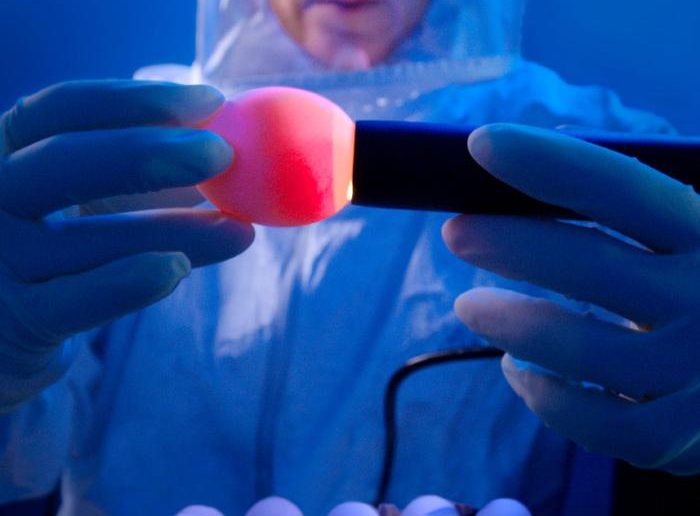
Embryonated chicken egg.
Photograph by CDC/ Laura R. Zambuto, James Gathany
In 2009, scientists scrambled to develop a vaccine against the H1N1 influenza pandemic. Although the first cases of illness were reported in March, a vaccine wasn’t ready in the U.S. until late September — a lag of almost seven months. Large amounts of vaccine weren’t available until several months after that. By then, the second wave of infections had peaked, as had much of the public’s concern about the illness. As a result, millions of vaccine doses sat in warehouses, unused.
Developing a vaccine against any illness is difficult and time-consuming, but the need for rapid vaccine production becomes even more important against emerging infectious diseases like H1N1 flu. One of the biggest hurdles in creating an influenza vaccine has to do with the virus itself. “In conventional vaccine-making, you need the actual virus that causes the disease,” says Phil Dormitzer, who leads a team of vaccine researchers at Novartis. “The bottleneck has been for a vaccine manufacturer to get its hands on a suitable vaccine virus.”
Dormitzer and his colleagues have found a way around this bottleneck, which they describe in a recent paper in Science Translational Medicine. They reconstructed the influenza genome based on a sequence they downloaded off the Internet. Using techniques from the field of synthetic genomics, the human-directed construction of genes and genomes, the team then created the viruses needed to produce a vaccine. With a synthetic version in-hand, vaccine development can take place before the real thing hits the human population. This approach is expected to dramatically decrease the production time for an influenza vaccine.
“Their methods are very creative,” says Mark Denison, a virologist at Vanderbilt University, who was not involved in the work. “What’s most important is that they figured out a way to make a virus quickly and accurately.”
The usual vaccine development process is an onerous one. First, scientists have to isolate the virus from a current outbreak. Then, the microbe has to be shipped to labs that are usually far away from the outbreak itself. Researchers must grow the candidate pathogen in eggs and then determine if the particular sample will yield enough virus, whether researchers can safely work with it to produce a vaccine, and whether the virus creates a robust immune response.
The first samples that emerged out of the H1N1 pandemic, Dormitzer notes, didn’t have good yields and weren’t very good at triggering an immune response. The world had to wait several months for the right virus to be isolated for use in a vaccine. In March, the U.S. Centers for Disease Control and Prevention published a report indicating that H1N1 vaccination prevented 700,000 to 1,500,000 cases. But the report authors note that more illnesses and deaths could have been prevented if the vaccine had been available earlier.
In spite of being a public health threat, the influenza virus holds a major advantage for Dormitzer’s team: Regardless of strain, most of the influenza genome remains constant from year to year. For the synthetic versions, researchers can have these unchanging portions waiting on the sidelines and ready to go when a pandemic strikes.
With the viral genetic backbone ready to go, all that’s left is to fill in the genetic code for the viral bits that do change: the hemagglutinin and neuraminidase proteins (the H and N referred to in the names of the flu strains, such as H1N1). And that’s what Dormitzer and colleagues describe in their latest work. The researchers inserted the reconstructed influenza genome into dog kidney cells, which can do the much more complicated work of creating the virus itself, using the information in the synthetic genome.
To mimic the conditions of an outbreak, Dormitzer’s group began with a partial sequence of an unknown influenza strain (the virus was H7N9, very similar to although not completely identical to the strain currently causing disease in China). After downloading the sequence, the researchers input the information into a synthetic genomics machine at 8 a.m. on Monday, August 29, 2011. This machine contains small vials of each of the four types of nucleotides, or building blocks, that form the influenza genome (influenza uses RNA instead of DNA, so these building blocks are A, G, C, and U). Based on the sequence information it receives, the machine adds the appropriate nucleotides in order, building short snippets of the genome. The researchers matched up overlapping ends of the snippets to assemble the complete influenza sequence, filling in the gaps in the partial sequence they received using other influenza virus sequences.
One thing that sped up the process was a new addition: a spell-checker protein in the form of an enzyme that double checked and corrected any mistakes in the sequence. Normally, researchers have to go through a lengthy process of making many copies of the DNA sequence and then looking for errors. This enzyme, however, could proofread and correct as the sequence building took place, just as word processing programs do while you type.
By midday on Tuesday, just a day after obtaining the initial partial sequence, the team had completed these two steps. Dormitzer and colleagues used the dog kidney cells to read the viral genome and produce a live virus. Two days later — late on Thursday — they had their final product. Early Friday morning, tests confirmed that the scientists had produced a complete virus. In a matter of a work week, a new virus was in-hand.
This method also allows quick synthesis of multiple viruses as possible vaccine candidates rather than requiring weeks or months working with one or two viruses at a time. “In practical terms, what we did very important to human health,” says Dormitzer. “When there’s a bad flu outbreak — or worse, a pandemic — it’s important to respond quickly.”
Dormitzer is quick to point out that the vaccine itself isn’t produced in a few days, just the virus. Manufacturers still need time to create and test the final product, which could take weeks or months. But with a variety of synthetic options at the ready, some work of vaccine development could actually precede an outbreak.
This vaccine development approach could apply to other pathogens as well, Dormitzer notes, although the regulatory hurdles would be higher than those for flu virus development, which are streamlined. The US Food and Drug Administration already has a process in place that allows companies to quickly distribute vaccines against new flu strains each year without having to start from scratch. With other diseases, the time for regulatory approval is so long that cutting off a few weeks by using synthetic viruses wouldn’t be a huge factor.
Even if the method currently can be applied only for influenza, the advance is still extremely significant, according to Denison, and not that far from what nature does. “Viruses, in some sense, are synthetic anyway. They don’t replicate outside of a host cell — they’re just self-replicating programming information,” he said.
Written by Carrie Arnold
Carrie Arnold is a freelance science writer living in Virginia. When she’s not writing about the weird and wonderful world around us, she’s likely drinking coffee, cycling, knitting, or annoying her cat. You can visit her website at www.carriearnold.com or check out her blog at www.edbites.com.]




